Olympics Flashback: 11 Key Moments of Atlanta 1996
Unforgettable moments from the first Games in the U.S. South
Photos courtesy Getty Images Olympics Lists
During the 1996 Atlanta Olympics, the first games hosted in the U.S. South, Georgia showcased its modernity and its corporate strength, embodied in brands such as Coca-Cola, CNN and Delta Airlines. The Atlanta Games marked the introduction of new Olympic sports, heroic athletic achievements, and both the introduction and farewell of several sporting careers. They provided many unforgettable moments, not all of them positive. 20 years later, here are 10 incidents that captivated the world.
THE CHAMP LIGHTS THE LAMP
During the opening ceremonies more than 10,000 athletes from 197 countries participated in The Parade of Nations as 83,000 attendees looked on, including Presidents Clinton and Carter—himself a Georgian.
Muhammad Ali—himself a son of the south from Louisville, Kentucky—was asked to conclude the opening ceremony and mark the beginning of the ‘96 Games. The location was meaningful for him. In 1970, after three and a half years during which his heavyweight title was stripped for refusing induction into the U.S. Army, Ali’s fought his first comeback bout in Atlanta. Ali, his hands and forearms shaking from the effects of Parkinson’s syndrome, stoically accepted the Olympic torch and lit the Olympic Cauldron as the crowd erupted in appreciation of the man once considered the most famous person on earth. The Deep South, with its perplexing social history, had recognized The Greatest.
DOMESTIC TERROR

Centennial Park, with its corporate kiosks, kids frolicking in water spouts, and music concerts, served as the town square of the ’96 Games. On July 27, eight days into the Games, as television viewers watched a replay of a late night interview with swimmer Janet Evans, the studio shook with a rumble. A terrorist’s bomb had exploded at a nearby concert. Law enforcement found three pipe bombs surrounded by three-inch-long masonry nails—with a steel plate as a directional device—tucked under a bench near the base of a sound tower. One woman was killed, a Turkish journalist later died of a heart attack from having run to the scene, and 111 people were injured, in the first major event of Olympic terrorism since the Black September group killed several Israeli athletes in their dorm during the Munich Olympics of 1972. A security guard named Richard Jewell found the bomb and cleared most of the spectators out of the park. Because of his discovery of the bomb and some inconsistencies in his accounts, Jewell was initially the FBI’s first suspect. But the bomb had been built and set in place by former handyman Eric Robert Rudolph. Had someone not moved it slightly, it could have done worse damage. When Centennial Olympic Park re-opened four days after the bombing, thousands showed up. Jewell was absolved in October, and Rudolph later convicted.
GOLD IN HIS SHOES

Michael Johnson was a sprinter from Baylor University. While articulate and opinionated, his accomplishments never garnered the headlines or controversy of a Carl Lewis. Yet Johnson was a force, and in Atlanta, he stood to engrave his name in history among the immortals. In track and field, during the second week of the Games, and after the shock of the Centennial Park bombing, Michael Johnson electrified the world by winning record-breaking gold medals in both the 200 and 400 meter dashes. The 200 meter field was particularly impressive, including Ato Boldon of Trinidad & Tobago, Namibia’s Frankie Fredericks, and Obadele Thompson of Barbados. The world thrilled to his blazing win in the 200. With his time of 19.32 seconds, he lowered the existing world mark by an astounding .34 of a second—about two decades worth of progress in one blazing curve. Then, in the 400, his time of 43.49 set a new Olympic record. Johnson was the first man to win the 200 and 400 meters in the same Olympics.
Though otherwise unassuming, Johnson accomplished all this sporting his trademark gold cleats. Johnson’s erect running style, reminiscent of 1936 100 and 200 meter gold medalist Jesse Owens, wowed spectators and media alike.
THE KING’S EXIT
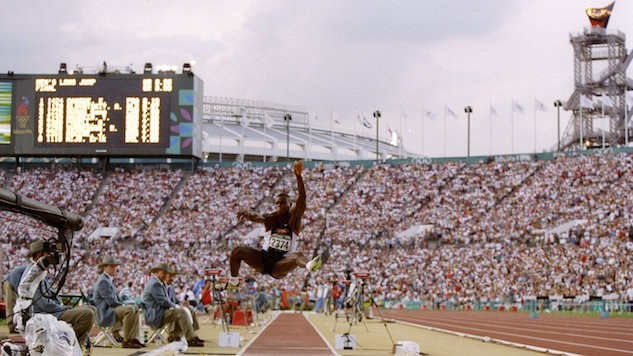
The U.S.’ Carl Lewis entered the Atlanta Games with eight career gold medals, including the long jump, 100 meter dash, 200 meter dash, and 4 × 100 meter relay. 12 years earlier, at the 1984 L.A. Games, Lewis matched Jesse Owens’ feat of gold in all four events. Now he was 35. Though not universally loved, most fans hoped Lewis’ final Olympic games proved successful. The King did not disappoint. In his third effort of the long jump, he leaped 27’10 ½”, besting Jamaica’s James Beckford, and securing his ninth gold medal. Still, the team decided to keep him off of the 4 × 100 meter relay. Given the flawless performance in that event by the Canadian quartet, Lewis’ participation would not have made a difference. The King was gone, but he went out much as he had entered—atop his athletic throne.
NEW JACK SWING

During the Atlanta Games, softball debuted as an Olympic sport. The games were played at the aptly named Golden Park in Columbus, Ga. In its inaugural game, the United States beat Puerto Rico 10-0. The USA squad’s stellar play introduced us to new heroes such as pitcher Lisa Fernandez and infielder Dot Richardson. Other strong entrants included Japan, China and Australia. In the gold medal game, millions watched as the US defeated China 3-1. Just like that, softball was a hit. This was a milestone in the recognition of women’s team sports in the U.S.—an achievement in a game most fans identified with, and had played a version of. A game of power, speed and wits. The winners appeared on NBC’s Today the morning after their triumph. Dot Richardson became a household name, and Fernandez a popular face on endorsement ads.
POCKET HERCULES
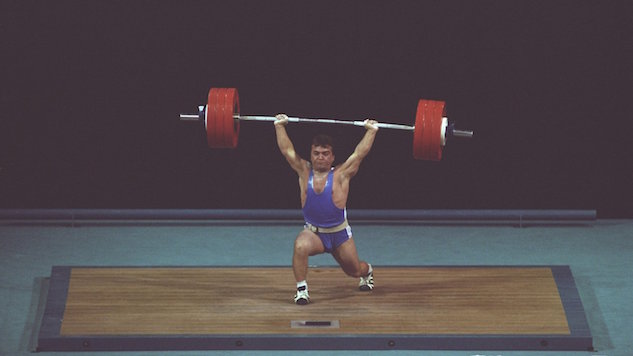
He stood 4’10”, and weighed 132 pounds. He was born Naim Suleimanov in Bulgaria. He was the first weightlifter to lift 2.5 times his body weight. He is the only weightlifter to clean and jerk 190 kilos—more than triple his bodyweight. At the Atlanta Games, Naim Süleymano?lu of Turkey, nicknamed “Pocket Hercules,” became the first weightlifter to win three Olympic gold medals. The lifts were swift and powerful, but the journey to that stage was long and arduous. Süleymano?lu set his first world record at the age 16. He missed his first chance at Olympic gold in 1984 because Bulgaria boycotted the ’84 L.A. Games along with the Soviet Union. Not long after, the Communist regime in Bulgaria forced its Turkish minority to adopt Bulgarian names and he became known as Naim Suleimanov. During the World Cup Weightlifting Final in Melbourne in 1986, Suleimanov defected. He applied for citizenship in Turkey, and changed his name from the Bulgarian Suleimanov/Shalamanov to Süleymano?lu.
His conviction proved as strong as his physique. Süleymano?lu’s defection sparked a fight over which nation he he would represent in the 1988 Seoul Games, which ultimately culminated in a $1,250,000 payment to Bulgaria from Turkey to allow him to compete for Turkey. In Seoul he won the featherweight gold medal, hoisting enough weight to win the weight class above his. The tiny titan returned to competition in 1991, and won his second gold in 1992 in Barcelona. In Atlanta, it was assumed he was in his last Olympics. Politics entered again. His rival was Greece’s Valerios Leonidis, and the audience was split between Greeks and Turkish rooters. The battle climaxed as the two traded three straight world-record lifts. Süleymano?lu raised 413.37 pounds, then Leonidis failed to lift 418.88 pounds. The Greek athlete began crying. Süleymano?lu made global news when he consoled the emotional silver medalist. The Pocket Hercules, then 29, did not retire after Atlanta, but that third consecutive gold medal was his final victorious feat of strength.
A LITTLE COURAGE
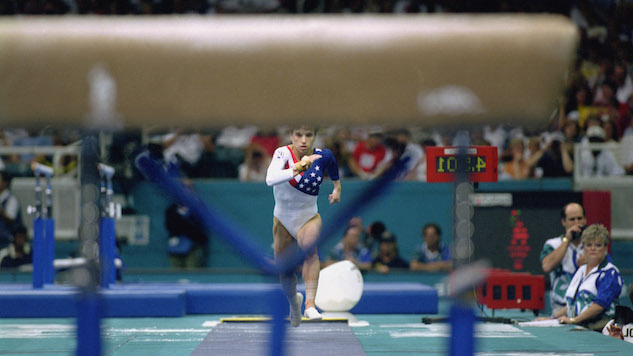
As the youngest member of the U.S. team at 14, Tucson-born Kerri Strug had won a team bronze medal at the Barcelona Olympics of 1992. Strug worked her way back to the U.S. national team in 1995 after an injury sustained during a routine on the uneven bars, but finished without a medal. In 1996, she made the U.S. Olympic team, nicknamed The Magnificent Seven (Shannon Miller, Dominique Moceanu, Dominique Dawes, Strug, Amy Chow, Amanda Borden, and Jaycie Phelps). Going into the vault, the U.S. was leading Russia in team competition. In the vault competition, each gymnast vaults twice, with their lowest score being thrown out. Prior to Strug’s turn, Moceanu’s two efforts both resulted in backwards falls from the vault, earning her a score of 9.2—the USA needed a 9.43 to win gold. Strug executed the same vault as Moceanu, and also fell back. When she rose, it was clear she had injured herself. Károlyi encouraged her, bellowing, “You can do it, Kerri!” If Strug decided against a second vault, she’d finish fourth on her squad, missing out on the all-around competition. Strug walked on the sore ankle and tried to minimize the pain by putting weight on it as she approached the beginning on the runway. TV viewers could hear her coach and teammates cheering her on. What they could not hear, though, was Strug asking Károlyi, “Do we need this?”
The coach replied, “Kerri, we need you to go one more time. We need you one more time for the gold. You can do it, you better do it.”
The world held its collective breath—she was going to try a second effort. Strug vaulted much better this time, landing on both feet, but instantly hopping onto her good foot, and gestured toward the judges. The arena went wild with approval and admiration. Strug fell to her knees and had to be carried off the podium. She was carted to a hospital tent. The U.S won the gold, the first ever for its women’s gymnastics team. What the team had not known was that due to a poor performance by Russia’s Roza Galieva, Moceanu’s failed second vault would have guaranteed them a gold even if Strug decided against a second attempt. But instead, she emerged as a legend and what passed in 1996 as a viral sensation.
Though Strug qualified for vault finals, and the all-around competition, she couldn’t compete with her injury—Moceanu replaced her. Miller subbed for her in the vault finals, and Dawes took in floor routine. But for all the glory of The Magnificent Seven, Strug’s struggle symbolizes their success.
A SWEETHEART RETIRES
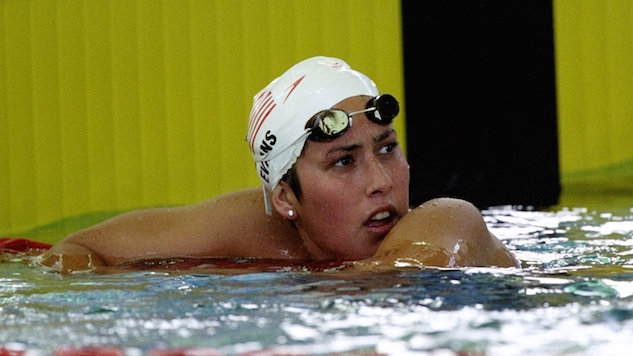
American swimmer Janet Evans started winning meets at age 11. At the 1988 Summer Olympics in Seoul, the Stanford swimmer won three individual gold medals, earning adoration as America’s Sweetheart, which led to endorsements and many media profiles of an athlete at once charming and fiery. Her Seoul world record in the 400 freestyle was not broken for 18 years. In ‘96, she had the honor of passing the Olympic torch to Muhammad Ali during the opening ceremony. While competition in the pool was disappointing for her and her millions of supporters—she finished ninth in the prelims of the 400-meter freestyle and closed her career with a sixth place finish in the 800-meter freestyle—she was still a symbolic face of the Games. On July 27, 1996, she was being interviewed by a German TV journalist when the Centennial Park bomb exploded, visibly shaking the set and startling Evans. NBC replayed the moment almost immediately. It did so for hours during subsequent reports concerning the attack. The irony of the beloved and upbeat Evans being on set during the blast made that ugly occurrence even more grave.
IRISH DERBY
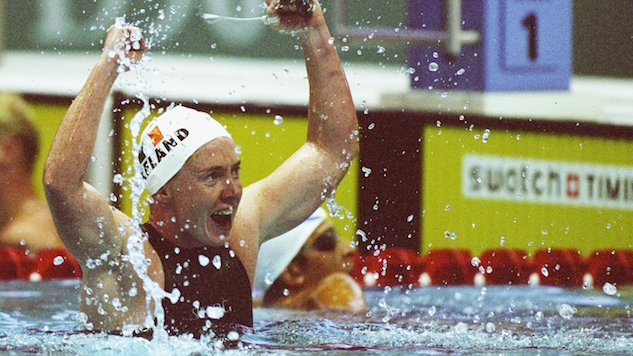
When Michelle Smith was a nine-year-old girl, a lifeguard at Tallaght Pool suggested to her father that she swim competitively. By age 14, Smith won 10 medals at the Irish national swimming championships. The year before Atlanta, she set national records in the 50 meters, 100 meters, 400 meters and 800 meters freestyle, 100 backstroke, 100 and 200 butterfly, and 200 meter and 400 meter individual medley events.
In Atlanta, she eventually qualified for the 400, pushing the U.S.’ Janet Evans to ninth place and out of the finals in the process. Smith went on to win the 400 meter freestyle, then the 400 meter individual medley. She captured her third gold of the games in the 200 individual medley. Thanks to her, Ireland won the second most overall Olympic medals in its history during the ’96 Games.
Rumors swirled around her throughout that she had been using performance-enhancing drugs—critics pointed to her unlikely rise from 90th in the world to world champion in three years. In 1998, FINA banned Smith for four years after finding her urine sample tainted with alcohol. She then lost her appeal to the Court of Arbitration for Sport (CAS), who determined Smith had taken Androstenedione, a metabolic precursor of testosterone. Then 28, she retired and went on to a successful career in law.
HOMER BLASTS

Atlanta-Fulton County Stadium was where Henry Aaron had broken Babe Ruth’s career home run record by hitting his 715th round tripper in April 1974. By 1996, baseball was an Olympic sport, having been introduced at the ’92 Barcelona Games. Cuba, the U.S., Nicaragua and Japan had all fielded strong teams to Atlanta. 52,384 people turned out to see the U.S. take on Japan on Thursday, July 25. The U.S. had scored only 11 runs in its first two games. In the game with Japan, their bats came alive. They hit five home runs, four of them in a row, in the first inning of a 15-5 rout. Seven of the nine starters had homered for the host nation. The game was stopped in the seventh inning by the Olympic “mercy rule” concerning 10-run leads. That convincing win, on the heels of another 15-run outing vs. Italy, set the U.S. on an apparent gold medal collision course with Cuba, who had won 138 consecutive international games. But in the semifinal round, Japan came back to eliminate the U.S. 11-2, exacting revenge for the previous power surge of their cocky hosts. The U.S. downed the Nicaraguans in the bronze medal game, while the Cubans prevailed 13-9 over the Japanese for the Gold.
QUICKEST QUARTET
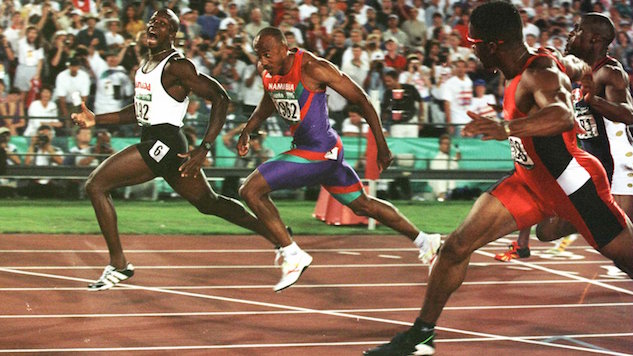
At the Atlanta Games, in arguably the fastest mens’ 100-meter dash finals field ever, Canada’s Donovan Bailey shot to victory in 9.84 brilliant and exuberant seconds. Though the UK’s great Linford Christie was disqualified from that final on the event’s second false start, robbing the fans and Christie of what could have been a grander finale, Bailey flew past Frankie Fredericks (silver) and Ato Boldon (bronze)—both of whom ran at least 9.9 seconds. Bailey’s burst pushed them all. The day of the men’s 4 × 100 meter relay final, the stadium bristled with anticipation, amid uncertainty regarding the makeup of the U.S. squad, which could feature Carl Lewis in his final Games, and questions about whether Bailey could anchor Canada to gold. Brazil and Cuba were also in medal contention.
Canada’s Robert Esmie ran leadoff, his head shaved to reveal the letters “Blast Off”. Esmie gave his team a strong start on the initial bend, then passed expertly off to Glenroy Gilbert, who ran against American Tim Harden. Those two fought down the straight, but Canada was in good position as Gilbert handed the baton to Bruny Surin. Then, the race changed, Surin taking on the curve like a runaway Rail Canada car, achieving separation from his closest competitor. The other nations were cooked with new 100-meter record holder Bailey waiting to anchor. Surin placed the stick in his teammate’s hand, then raised his arms upwards in victory as he watched Bailey barrel down the last 90 meters, the gap between him and the pursuit widening as he burned the concluding 20 meters. Canada finished in 37.69 seconds, the U.S. in 38.05, and Brazil in 38.41. No one knew the race marked the end of an era. Though most of the Canadian team was of Caribbean descent, in the next century, Jamaica would field 4 × 100 meter quartets who ran like superheroes, setting a new standard for the event. But on August 3, 1996, members of the Caribbean diaspora shone for the maple leaf, as their efficient handoffs and determined handling of the curves resulted in the brightest medal.
Cultural critic Bijan C. Bayne is the author of Martha’s Vineyard Basketball: How a Resort League Defied Notions of Race & Class. His Twitter handle is @bijancbayne